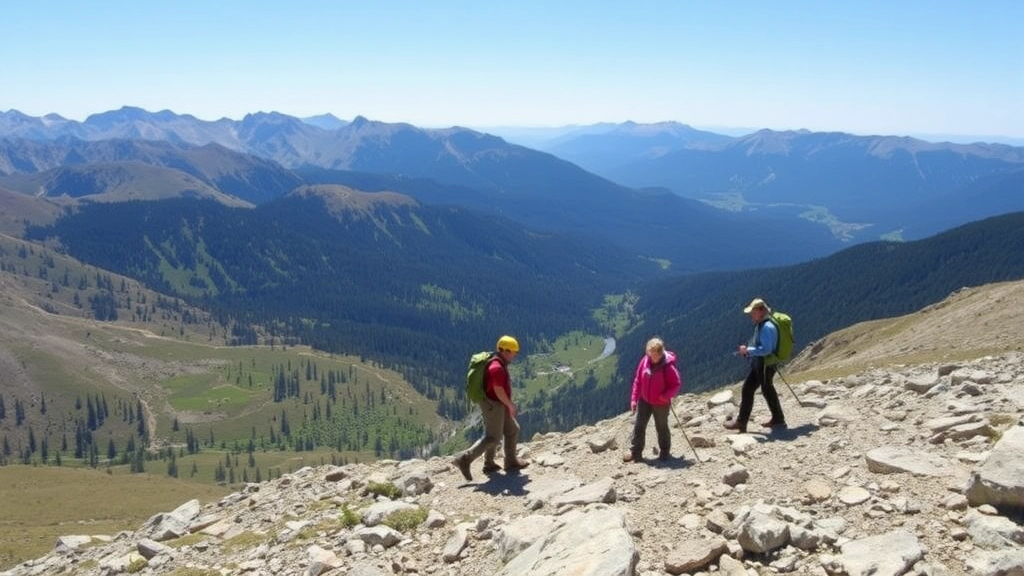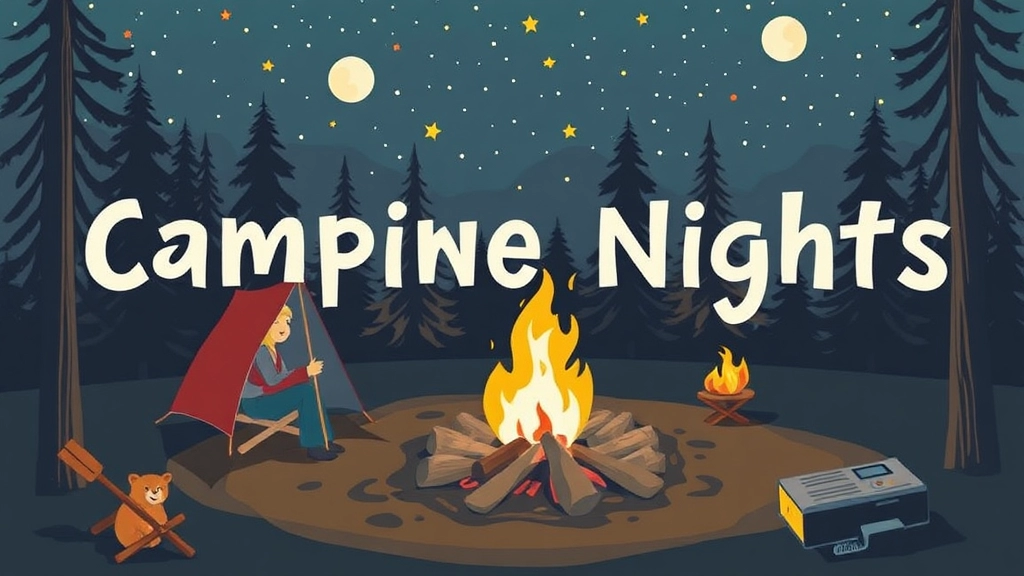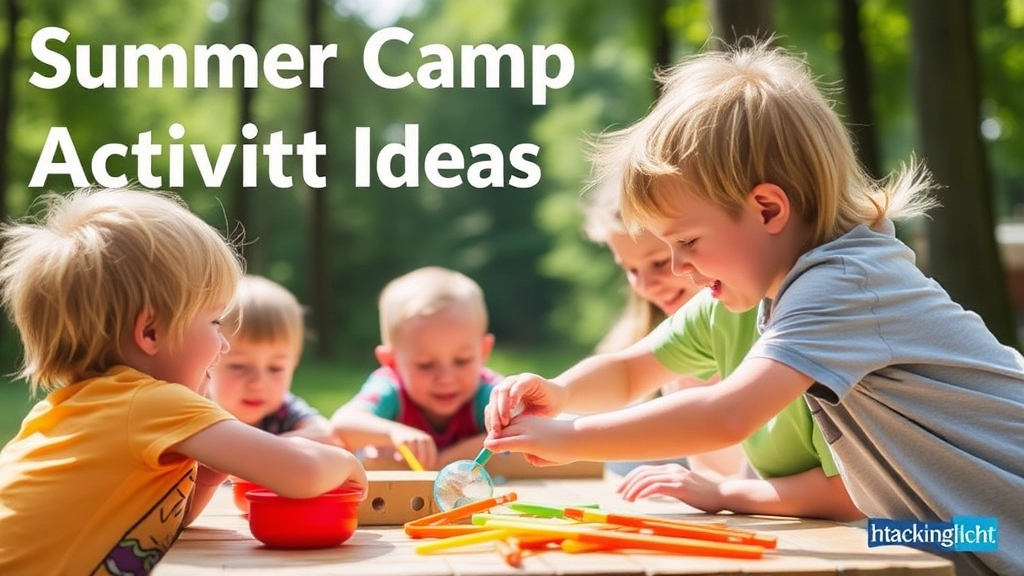Planning a Summer Camp
Planning a summer camp can be a daunting task, but with the right summer camp activity ideas, it can turn into an unforgettable experience for everyone involved. From creative arts and crafts to outdoor adventure challenges, this article will guide you through a variety of engaging and educational activities that promise to keep kids entertained and learning.
Activity Ideas
We’ll explore a wide range of activities including:
- Team-building games
- Educational science experiments
- Water-based fun
- Themed campfire nights
- Nature exploration
- Sports
- Cultural and music workshops
- DIY projects
Detailed Insights
Each section provides detailed insights and practical tips to ensure these activities are both fun and beneficial, making your summer camp the highlight of the season.
Creative Arts and Crafts Activities
Alright, let’s dive into the world of Creative Arts and Crafts Activities. Ever wondered how to keep kids engaged without them zoning out in front of screens? Yeah, me too. Let’s talk about how we can make creativity a blast for everyone involved.
Why Creative Arts and Crafts?
First off, why even bother with arts and crafts? Simple. It’s not just about making pretty things; it’s about boosting creativity, fine motor skills, and even problem-solving abilities. Plus, it’s a killer way to keep kids entertained and away from tech overload.
Benefits of Arts and Crafts
- Boosts Creativity: Let’s face it, kids have wild imaginations. Arts and crafts give them an outlet to express that.
- Improves Fine Motor Skills: Cutting, gluing, and drawing help in refining those tiny muscles in their hands.
- Encourages Problem Solving: Ever tried to make a paper mache volcano? It’s a mini engineering project!
Types of Arts and Crafts Activities
So, what kind of activities are we talking about here? Let’s break it down:
Painting and Drawing
Remember when you were a kid, and painting was the highlight of your day? It’s still a hit.
- Watercolours: Easy to clean up and fun to use.
- Acrylics: For those who want to get a bit more serious.
- Crayons and Markers: Perfect for younger kids.
Sculpting and Modelling
This is where things get hands-on. Think clay, playdough, or even paper mache.
- Clay Modelling: Great for detailed work and long-term projects.
- Playdough: Easy to use and perfect for younger kids.
- Paper Mache: Messy but incredibly rewarding.
Crafting with Recycled Materials
Why not teach kids about sustainability while they’re at it? Use old bottles, cardboard, and other recyclables to create something new.
- Bottle Rockets: A fun way to learn about propulsion.
- Cardboard Castles: Let their imaginations run wild.
- Recycled Robots: A bit of tin foil and some old boxes can go a long way.
Seasonal Crafts
Make crafts relevant to the time of year. Trust me, it makes a difference.
- Halloween Decorations: Pumpkins, ghosts, and ghouls.
- Christmas Ornaments: Get festive with some homemade decorations.
- Spring Flowers: Brighten up the place with some paper blooms.
Real-Life Stories
You know, I remember this one time at camp. We had a group of kids who were initially reluctant to join in on the arts and crafts. But once we got them started on a simple projectâmaking friendship braceletsâthey were hooked. By the end of the week, they were creating intricate designs and even teaching each other new techniques. It was incredible to see how a simple activity could bring them together and build their confidence.
For more inspiration on summer camp activities, check out our summer camp art activities and learn about the fun activities at summer camp.
Outdoor Adventure Challenges

Ever wondered how to get the kids off their screens and into the great outdoors?
Outdoor adventure challenges are the answer.
Not only do they boost physical fitness, but they also build resilience and teamwork.
Let’s dive into some of the best activities you can set up.
Rock Climbing
Rock climbing is a fantastic way to push boundaries.
It’s not just about strength but also problem-solving and focus.
You don’t need a mountain; a climbing wall will do.
Benefits:
- Builds upper body strength
- Enhances problem-solving skills
- Improves focus and concentration
Orienteering
Orienteering is like a treasure hunt but with maps and compasses.
Kids learn navigation skills while having a blast.
Benefits:
- Teaches map-reading
- Encourages strategic thinking
- Promotes teamwork
Obstacle Courses
Think of Ninja Warrior but for kids.
Set up an obstacle course with ropes, tyres, and balance beams.
Benefits:
- Improves agility
- Encourages perseverance
- Fun and engaging
Zip Lining
Who doesn’t love the thrill of flying through the air?
Zip lining is a surefire way to get the adrenaline pumping.
Benefits:
- Boosts confidence
- Offers a unique perspective of nature
- Pure fun
Survival Skills Workshops
Teach the basics of survival: building shelters, starting a fire, and finding food.
It’s practical and exciting.
Benefits:
- Teaches essential life skills
- Encourages problem-solving
- Builds confidence
Canoeing/Kayaking
If you have access to a lake or river, canoeing or kayaking is a must.
It’s a great way to explore the water and build upper body strength.
Benefits:
- Enhances coordination
- Builds upper body strength
- Encourages teamwork
Real Stories, Real Fun
Last summer, we set up an obstacle course for a group of kids.
At first, they were hesitant.
By the end of the day, they were racing through it like pros.
The smiles were priceless.
Team Building Games
Why Team Building Games Matter
Ever wondered why some teams click while others struggle? It’s all about chemistry and trust. Team building games are the secret sauce that can transform a group of strangers into a tight-knit crew. Trust me, I’ve seen it happen. Whether you’re running a summer camp, a corporate retreat, or just a weekend getaway with friends, these games can make a world of difference.
Types of Team Building Games
Alright, let’s break it down. There are tons of team building games out there, but I’ve curated a list of the best ones that are fun, engaging, and actually work.
1. Trust Falls
Yeah, I know, it’s a classic. But it’s a classic for a reason. Trust falls are simple yet powerful. They force you to literally fall into someone’s arms, building trust and breaking down barriers.
2. Human Knot
This one’s a bit more hands-on. Everyone stands in a circle, grabs hands with two different people not next to them, and then tries to untangle the knot without letting go. It’s chaotic, it’s fun, and it’s a great icebreaker.
3. Scavenger Hunts
Who doesn’t love a good scavenger hunt? Split into teams, hand out a list of items or tasks, and let the chaos ensue. It’s a brilliant way to encourage teamwork and problem-solving.
How to Make Team Building Games Effective
Alright, so you’ve got your games lined up. But how do you make sure they actually build the team?
- Set Clear Objectives: Know what you want to achieve. Is it trust? Communication? Problem-solving? Tailor your games to these goals.
- Debrief: After each game, take a few minutes to discuss what happened. What did you learn? How did you feel? This reflection is where the real growth happens.
- Mix it Up: Don’t stick to one type of game. Variety keeps things fresh and ensures you’re hitting different aspects of team building.
Real-Life Example
Let me share a quick story. Last summer, I was running a camp and decided to kick things off with a human knot game. The kids were awkward and shy at first, but by the end of it, they were laughing and high-fiving like old friends. It set the tone for the entire camp and made the rest of the activities way more engaging.
Challenges and Solutions
Of course, not everything goes smoothly. Sometimes people are hesitant or just not into it. Here’s how to handle that:
Educational Science Experiments

Ever wondered how to make science fun for kids?
Yeah, me too.
Educational science experiments are the way to go.
They’re hands-on, engaging, and kids love them.
Why Science Experiments?
Science can feel like a drag for many kids.
But when you turn it into an experiment, it’s a game-changer.
Benefits:
- Hands-on Learning: Kids get to touch, see, and feel science.
- Curiosity Boost: They start asking questions. Lots of them.
- Teamwork: Many experiments need teamwork. It’s a win-win.
Easy Experiments to Start With:
- Volcano Eruption:
- Baking soda
- Vinegar
- A bit of food colouring
- Boom! You’ve got a mini volcano.
- Slime Making:
- Glue
- Borax solution
- Mix and you’ve got stretchy, gooey slime.
- Invisible Ink:
- Lemon juice
- Cotton swab
- Paper
- Write a message, let it dry, and reveal it with heat.
Why These Work:
- Simple Ingredients: You probably already have these at home.
- Quick Results: Kids don’t have to wait forever to see the magic.
- Safe: No dangerous chemicals. Just good, clean fun.
Pro Tips:
- Supervision: Always keep an eye on the kids.
- Explain the Science: Break down what’s happening. Make it simple.
- Let Them Lead: Give them control. They’ll love it.
Stories from the Field:
I remember the first time I did the volcano eruption with my nephew.
His eyes lit up like it was Christmas morning.
He couldn’t stop talking about it for days.
And that’s the magic of science experiments.
Water-Based Fun Activities
Alright, let’s dive right in. Water-based activities are a blast, but let’s be realâmost of us have a few concerns. “Will it be safe?” “What if I can’t swim well?” “Is it going to be fun for everyone?” Trust me, I’ve got you covered. Let’s break it down and make it simple and engaging.
Why Water-Based Activities?
Water-based activities are more than just splashing around. They’re fantastic for cooling off on a hot day, building physical strength, and fostering teamwork. Plus, they add a whole new level of excitement to any camp or outing.
Types of Water-Based Fun Activities
Here’s a quick list of activities that are sure to make a splash:
- Kayaking and Canoeing: Perfect for those who want to explore and have a bit of an adventure. It’s a great way to build upper body strength and teamwork.
- Swimming Races: Simple yet effective. Organize different types of racesâfreestyle, backstroke, or even relay races.
- Water Balloon Fights: Who doesn’t love a good water balloon fight? It’s a fun way to cool down and get everyone involved.
- Paddleboarding: This activity is excellent for balance and core strength. Plus, it’s super trendy right now.
- Water Obstacle Courses: Set up a course with floating obstacles. It’s challenging and fun.
Safety First
Let’s address the elephant in the roomâsafety. Here are some tips to keep everyone safe:
- Life Jackets: Always have life jackets available, especially for those who aren’t strong swimmers.
- Supervision: Ensure there’s always a lifeguard or an adult supervising the activities.
- Buddy System: Pair up participants so they can look out for each other.
- Clear Rules: Set clear rules about what’s allowed and what’s not. No diving in shallow areas, no running near the pool, etc.
Personal Stories and Examples
I remember this one time when we set up a water obstacle course for a summer camp. The kids were hesitant at first, but once they got the hang of it, they were racing each other and having the time of their lives. One kid, who was initially scared of water, ended up being the fastest on the course by the end of the day. It’s amazing what a bit of encouragement can do.
Benefits of Water-Based Activities
- Physical Fitness: Swimming and other water activities are excellent for cardiovascular health.
- Teamwork: Activities like kayaking and water balloon fights require coordination and cooperation.
- Confidence Building: Overcoming fears, like swimming in deep water, can significantly boost self-confidence.
- Cooling Off: Let’s not forget, it’s a fantastic way to beat the heat.
For more tips on making the most of your summer camp experience, check out our guide on classic summer camp activities. If you’re planning a trip, don’t miss our top tips for summer camp field trips.
Themed Campfire Nights

Ever wondered how to make campfire nights more exciting?
We’ve got you covered.
Imagine sitting around a blazing fire, the night sky above, and everyone’s faces lit up with anticipation.
Sounds magical, right?
But let’s take it up a notch.
Why Themed Campfire Nights?
Themed campfire nights are a game-changer.
They turn a simple gathering into an unforgettable experience.
Here’s why you should consider them:
- Variety: Each night is different, keeping everyone engaged.
- Inclusivity: Themes can cater to all ages and interests.
- Memories: Unique themes create lasting memories.
Popular Themes to Try
You don’t need to reinvent the wheel.
Here are some tried-and-true themes that work wonders:
- Storytelling Night: Share ghost stories, fairy tales, or personal anecdotes.
- Music Jam Session: Bring instruments, sing along, or simply enjoy the tunes.
- Costume Party: Dress up according to the theme—pirates, superheroes, you name it.
- Talent Show: Showcase hidden talents—singing, dancing, magic tricks.
- Trivia Night: Prepare questions on various topics and divide into teams.
How to Make It Happen
Planning is key.
Here’s a simple checklist to get you started:
- Choose a Theme: Pick something everyone will enjoy.
- Set the Scene: Decorate the area to match the theme.
- Prepare Activities: Plan games, songs, or stories that fit the theme.
- Gather Supplies: Make sure you have everything you need—props, instruments, costumes.
- Involve Everyone: Encourage participation to make it more fun.
Real-Life Example
Last summer, we had a “Mystery Night” theme.
Everyone came dressed as detectives.
We had a mock crime scene and clues hidden around the campfire area.
It was a hit!
People still talk about it.
Ready to make your next campfire night unforgettable?
Give themed campfire nights a try.
You’ll thank me later.
Nature Exploration and Hikes
Ever wondered how to get kids off their screens and into the great outdoors? Nature exploration and hikes might be your golden ticket. Seriously, there’s something magical about stepping into the wild, breathing in the fresh air, and discovering the wonders of nature. But let’s break it down, shall we?
Why Nature Exploration and Hikes?
First off, why should we even bother with nature exploration and hikes? Well, here’s the deal:
- Physical Health: Hiking is a fantastic way to get moving. It’s like a workout, but way more fun.
- Mental Well-being: Nature has this uncanny ability to calm the mind. Trust me, a walk in the woods can do wonders for stress.
- Learning Opportunities: The outdoors is a living classroom. From identifying plants to understanding ecosystems, there’s a ton to learn.
Planning Your Hike
Alright, so how do we actually go about planning a hike? Here’s a simple checklist:
- Choose a Trail: Pick a trail that matches the group’s fitness level. Apps like AllTrails can help you find the perfect spot.
- Gear Up: Make sure everyone has the right gear. Comfortable shoes, water bottles, and maybe a snack or two. Check out our summer camping top tips and gear essentials for more advice.
- Safety First: Always let someone know your plans. Carry a basic first aid kit and be aware of the local wildlife.
Making It Fun
Now, let’s talk about making the hike engaging. Here are a few ideas:
- Scavenger Hunts: Create a list of items to find. Think leaves, rocks, or even animal tracks.
- Storytelling: Share stories about the area’s history or folklore. It adds a layer of intrigue.
- Photography: Encourage everyone to take photos. It’s a great way to capture memories and appreciate the beauty around them. For tips, see our guide on capturing stunning summer camping photos.
Real-Life Example
I remember taking a group of kids on a hike in the Lake District. Initially, they were reluctant, glued to their phones. But once we started, they were captivated by the scenery. We even spotted a family of deer, which was the highlight of the day. By the end, they were planning their next hike. It’s moments like these that make it all worthwhile.
Benefits Beyond the Trail
Nature exploration and hikes aren’t just about the time spent outdoors. They offer benefits that extend far beyond the trail:
Sports and Physical Fitness Activities

Feeling sluggish and out of shape?
Wondering how to get kids moving and grooving?
We’ve all been there.
Physical fitness is crucial for everyone, especially kids.
Let’s dive into some fun and engaging sports and physical fitness activities that will get everyone pumped up.
Why Sports Matter
Sports aren’t just about physical health.
They teach teamwork, discipline, and resilience.
And let’s face it, they’re a blast!
Variety of Sports
Mix it up!
Sticking to one sport can get boring.
Here are some ideas to keep things fresh:
- Football: Great for building teamwork.
- Basketball: Improves hand-eye coordination.
- Tennis: Boosts agility and quick thinking.
- Swimming: Full-body workout, plus it’s fun!
Fun Fitness Challenges
Make it a game.
Nobody likes boring workouts.
Try these fun fitness challenges:
- Obstacle Courses: Use cones, ropes, and tyres.
- Relay Races: Spice it up with different tasks.
- Fitness Bingo: Create a bingo card with exercises.
Group Activities
Team spirit is everything.
Group activities can make fitness more enjoyable.
Consider:
- Capture the Flag: Combines strategy and physical activity.
- Dodgeball: Fast-paced and exciting.
- Tug of War: Simple yet effective.
Stories and Examples
Remember when we organised a football tournament last summer?
Kids were initially hesitant, but by the end, they were all in, cheering and strategizing.
It wasn’t just about winning; it was about the camaraderie.
Keeping It Safe
Safety first.
Always ensure:
- Proper warm-up and cool-down sessions.
- Adequate hydration.
- Supervision to prevent injuries.
Final Thoughts
Sports and physical fitness activities are essential for a healthy lifestyle.
They’re not just about burning calories but building character.
So, what are you waiting for?
Get out there and get moving!
Remember, the key is to keep it fun and engaging.
Sports and physical fitness activities can be the highlight of your day.
Cultural and Music Workshops
Ever wondered how to get kids genuinely excited about different cultures and music? Let’s dive into the magic of Cultural and Music Workshops. These activities aren’t just about having fun â they’re about expanding horizons, sparking curiosity, and building a deeper appreciation for the world around us.
Why Cultural and Music Workshops?
We all know the struggle: kids glued to screens, missing out on the richness of real-world experiences. Cultural and music workshops are the perfect antidote. They offer a hands-on, immersive way to learn about diverse traditions, instruments, and art forms from around the globe. Plus, they’re a blast!
Key Benefits:
- Enhances Cultural Awareness: Kids learn about different cultures, fostering empathy and understanding.
- Boosts Creativity: Exposure to various music styles and cultural arts can ignite a child’s creative spark.
- Encourages Teamwork: Many activities require collaboration, enhancing social skills and teamwork.
Types of Cultural and Music Workshops
1. World Music Exploration:
Imagine kids getting their hands on instruments like the djembe from Africa or the sitar from India. They can learn the basics, play simple rhythms, and even create their own music.
2. Dance Around the World:
From salsa to traditional folk dances, kids can learn various dance styles. It’s a fun way to get moving and understand the cultural significance behind each dance.
3. Cultural Craft Workshops:
Think of activities like making Japanese origami, creating African masks, or painting traditional Indian rangoli. These crafts are not only fun but also provide insights into different cultural art forms.
4. Storytelling Sessions:
Invite storytellers from different cultural backgrounds to share myths, legends, and folktales. This can be a powerful way to convey the values and traditions of various cultures.
5. Language and Music Fusion:
Combine language learning with music. Teach kids simple songs in different languages. It’s a fantastic way to make language learning engaging and memorable.
Practical Tips for Organising Workshops
Planning and Execution:
- Find the Right Experts: Collaborate with local musicians, dancers, and artists who specialise in different cultural forms.
- Interactive and Hands-On: Ensure workshops are interactive. Kids should be able to touch, play, and create.
- Keep it Age-Appropriate: Tailor activities to suit different age groups, ensuring they’re engaging and educational.
Materials Needed:
- Musical instruments from various cultures
- Art supplies for cultural crafts
- Costumes and props for dance workshops
- Books and audio-visual aids for storytelling sessions
Real Stories, Real Impact
Let me share a quick story. Last summer, we had a workshop where kids learned to play the didgeridoo, an Aboriginal Australian instrument. Initially, they struggled, but by the end of the week, they were creating beautiful sounds and even performed a small concert. The pride and joy on their faces were unforgettable.
Internal Links and Further Exploration
If you’re interested in more creative activities, check out our section on Creative Ideas for 2024. For those who love the outdoors, our Fun Activities at Summer Camp section might be just what you need.
DIY Projects and Skill Building
Ever thought, “How can I make this camp experience more engaging for everyone?”
DIY projects and skill-building activities are your answer.
Trust me, they’re a game-changer.
Why DIY Projects?
DIY projects are hands-on.
They make you think, create, and problem-solve.
Plus, they’re fun.
You get to see the results of your hard work.
It’s like magic, but real.
Types of DIY Projects
Let’s break it down.
Here are some cool DIY ideas:
- Friendship Bracelets: Simple, colourful, and a great keepsake.
- Birdhouses: Teach kids about nature while they build.
- Recycled Crafts: Turn trash into treasure. Think bottle rockets or tin can lanterns.
- Homemade Slime: Messy but oh-so-satisfying.
For more creative ideas, check out our fun summer camp crafts for kids.
Skill Building
Skills are for life.
Here’s what you can focus on:
- Basic Carpentry: Hammering nails, sawing wood. It’s empowering.
- Cooking: Simple recipes that kids can do. Think campfire cooking.
- First Aid: Essential skills that everyone should know.
- Knot Tying: Useful for camping and everyday life.
Explore our summer camp activities for more skill-building opportunities.
Real Stories
I remember a camp where we built a garden from scratch.
Kids planted seeds, watered them, and watched them grow.
The pride on their faces was priceless.
Benefits of DIY and Skill Building
Why bother with DIY projects and skill-building?
Here’s why:
- Boosts Creativity: You think outside the box.
- Enhances Problem-Solving: You face challenges head-on.
- Builds Confidence: You see what you can achieve.
- Promotes Teamwork: You work together to get things done.
Quick Tips for Success
Want to nail this?
Here’s how:
FAQs on Summer Camp Activity Ideas
What are some outdoor adventure challenges for kids?
Outdoor adventure challenges include activities like rock climbing, orienteering, obstacle courses, zip lining, survival skills workshops, and canoeing/kayaking. These activities boost physical fitness, build resilience, and promote teamwork.
Why is rock climbing a good activity for kids?
Rock climbing builds upper body strength, enhances problem-solving skills, and improves focus and concentration. You don’t need a mountain; a climbing wall will suffice.
What skills do kids learn from orienteering?
Orienteering teaches map-reading, encourages strategic thinking, and promotes teamwork. It’s like a treasure hunt using maps and compasses.
How can obstacle courses benefit children?
Obstacle courses improve agility, encourage perseverance, and are fun and engaging. They can be set up with ropes, tyres, and balance beams.
What are the benefits of zip lining for kids?
Zip lining boosts confidence, offers a unique perspective of nature, and is pure fun. It’s a thrilling way to get kids excited about the outdoors.
What can kids learn from survival skills workshops?
Survival skills workshops teach essential life skills like building shelters, starting fires, and finding food. They also encourage problem-solving and build confidence.
Why should kids try canoeing or kayaking?
Canoeing or kayaking enhances coordination, builds upper body strength, and encourages teamwork. It’s a great way to explore water bodies.
How can educational science experiments be made fun?
Educational science experiments are hands-on, engaging, and loved by kids. They turn learning into a playful activity, making science exciting and interactive.
What are some easy science experiments to start with?
Some easy science experiments include volcano eruptions using baking soda and vinegar, slime making with glue and borax solution, and invisible ink with lemon juice. These experiments use simple ingredients and provide quick, safe results.
What are the benefits of themed campfire nights?
Themed campfire nights offer variety, inclusivity, and create lasting memories. They turn a simple gathering into an unforgettable experience with themes like storytelling, music jam sessions, costume parties, talent shows, and trivia nights.
How can you plan a successful themed campfire night?
To plan a successful themed campfire night, choose a theme, set the scene, prepare activities, gather supplies, and involve everyone. This ensures that the night is engaging and fun for all participants.
Why are sports and physical fitness activities important for kids?
Sports and physical fitness activities are crucial for physical health, teamwork, discipline, and resilience. They are also fun and engaging, helping kids stay active and healthy.
What are some fun fitness challenges for kids?
Fun fitness challenges include obstacle courses, relay races, and fitness bingo. These activities make workouts enjoyable and keep kids motivated to stay active.
How can you ensure safety during sports and physical activities?
Ensure safety by conducting proper warm-up and cool-down sessions, maintaining adequate hydration, and providing supervision to prevent injuries. Safety should always be a priority.
References
-
Rock Climbing Benefits
-
Why Orienteering?
-
Themed Campfire Nights

